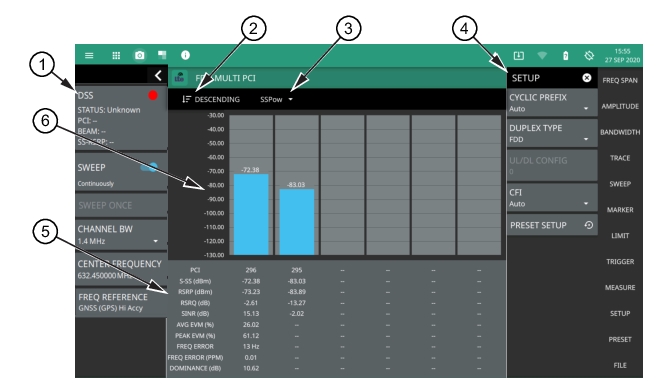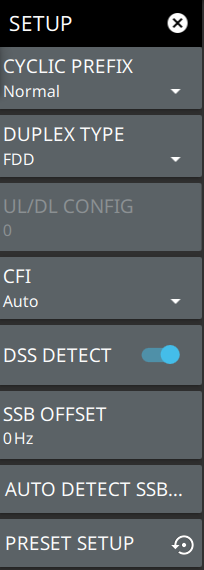 |
1. LTE Analyzer Status Panel: Each measurement features a unique status panel that displays settings and information relevant to the current measurement and view settings. This panel provides quick access to the measurement frequency and band configuration. See Status Panel (LTE Multi PCI). 2. Sort: Sets the selected measurement sort order of Descending or Ascending. 3. Bar Graph Measurement: Selects which measurement is plotted on the bar graph (RSRP, RSRQ, SINR, PCI, SS Power). 4. SETUP Menu: The control channel measurement settings are configured in the SETUP menu. See SETUP Menu (LTE Multi PCI). 5. Table Display: fields show the beam index value of the corresponding physical-layer cell ID. • PCI: These fields show the physical-layer cell ID number. When PCI is selected for the bar graph measurement, the values can be sorted in ascending or descending order by tapping the sort button in the bar graph header. • S-SS (dBm): These fields show the secondary synchronization signal power of the corresponding physical-layer cell ID, measured in dBm. When SSPower is selected for the bar graph measurement, the values can be sorted in ascending or descending order by tapping the sort button in the bar graph header. • RSRP (dBm): These fields show the reference signal received power, the average power of resource elements (RE) that carry cell-specific reference signals (RS) over the entire bandwidth. When RSRP is selected for the bar graph measurement, the values can be sorted in ascending or descending order by tapping the sort button in the bar graph header. • RSRQ (dB): These fields show the reference signal received quality, which provide additional information when RSRP is not sufficient to make a reliable handover or cell reselection decision. RSRQ is the ratio between RSRP and RSSI measured in dB. When RSRQ is selected for the bar graph measurement, the values can be sorted in ascending or descending order by tapping the sort button in the bar graph header. • SINR (dB): These fields show the signal-to-noise and interference ratio of the corresponding physical-layer cell ID, measured in dB. When SINR is selected for the bar graph measurement, the values can be sorted in ascending or descending order by tapping the sort button in the bar graph header. • AVG EVM (%): Shows the dominant cell’s AVG EVM of all of the error vectors between the reconstructed ideal signals and the received signals, divided by the RMS value of the ideal signals. • PEAK EVM (%): Shows the dominant cell’s peak EVM of all of the error vectors between the reconstructed ideal signals and the received signals, divided by the RMS value of the ideal signals. • FREQ ERROR (Hz and PPM): This is the difference between the measured carrier frequency and the specified carrier frequency of the dominant cell. This number is only as accurate as the frequency reference that is used, and is typically only useful with a good external frequency reference or GNSS (GPS). • DOMINANCE (dB): Dominance is the ratio of the dominant cell’s power for the largest signal to the sum of all other signals found, measured in dB. 6. Bar Graph Display: Shows the selected measurement as a bar graph with the current value at the top of the graph. |

